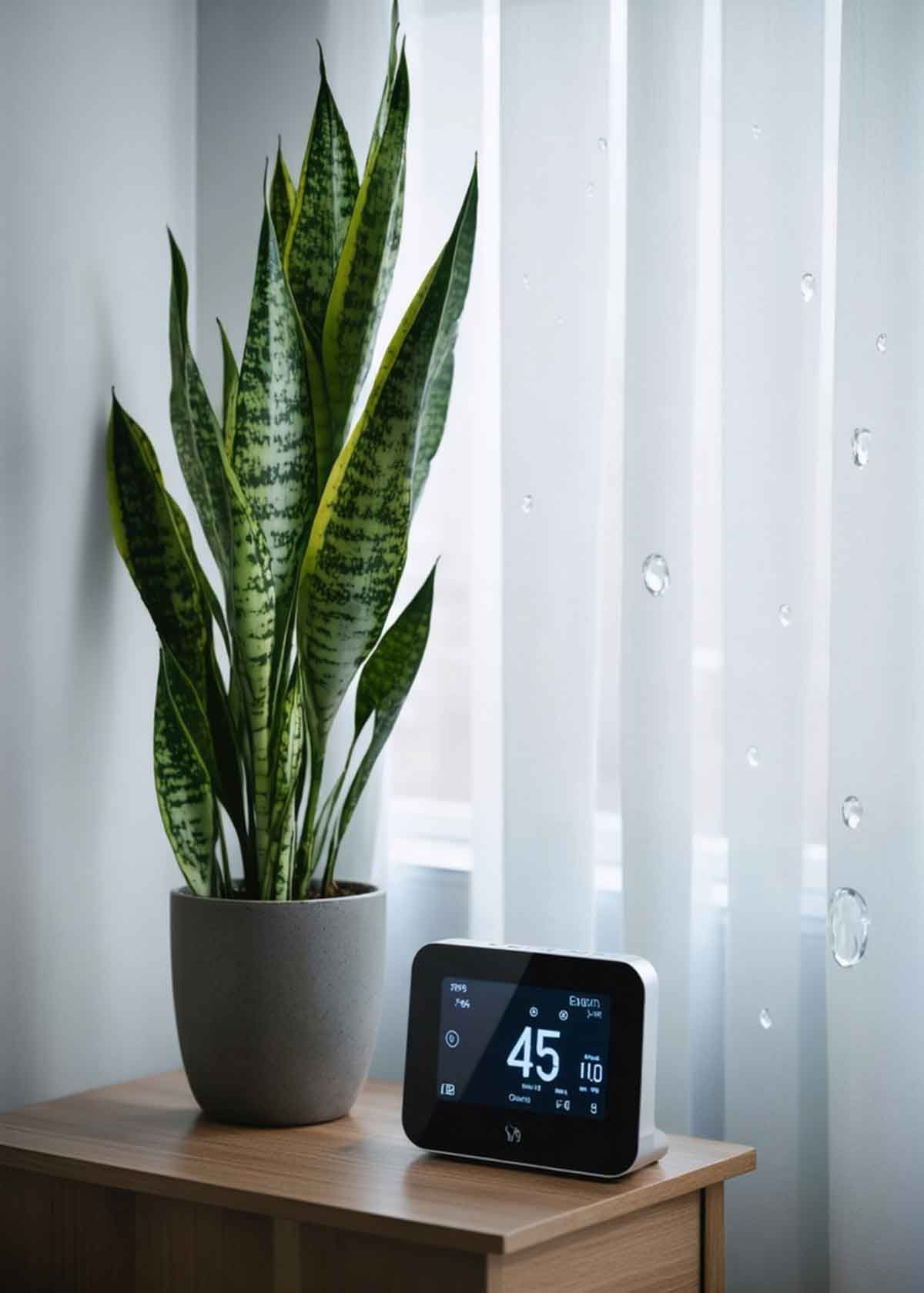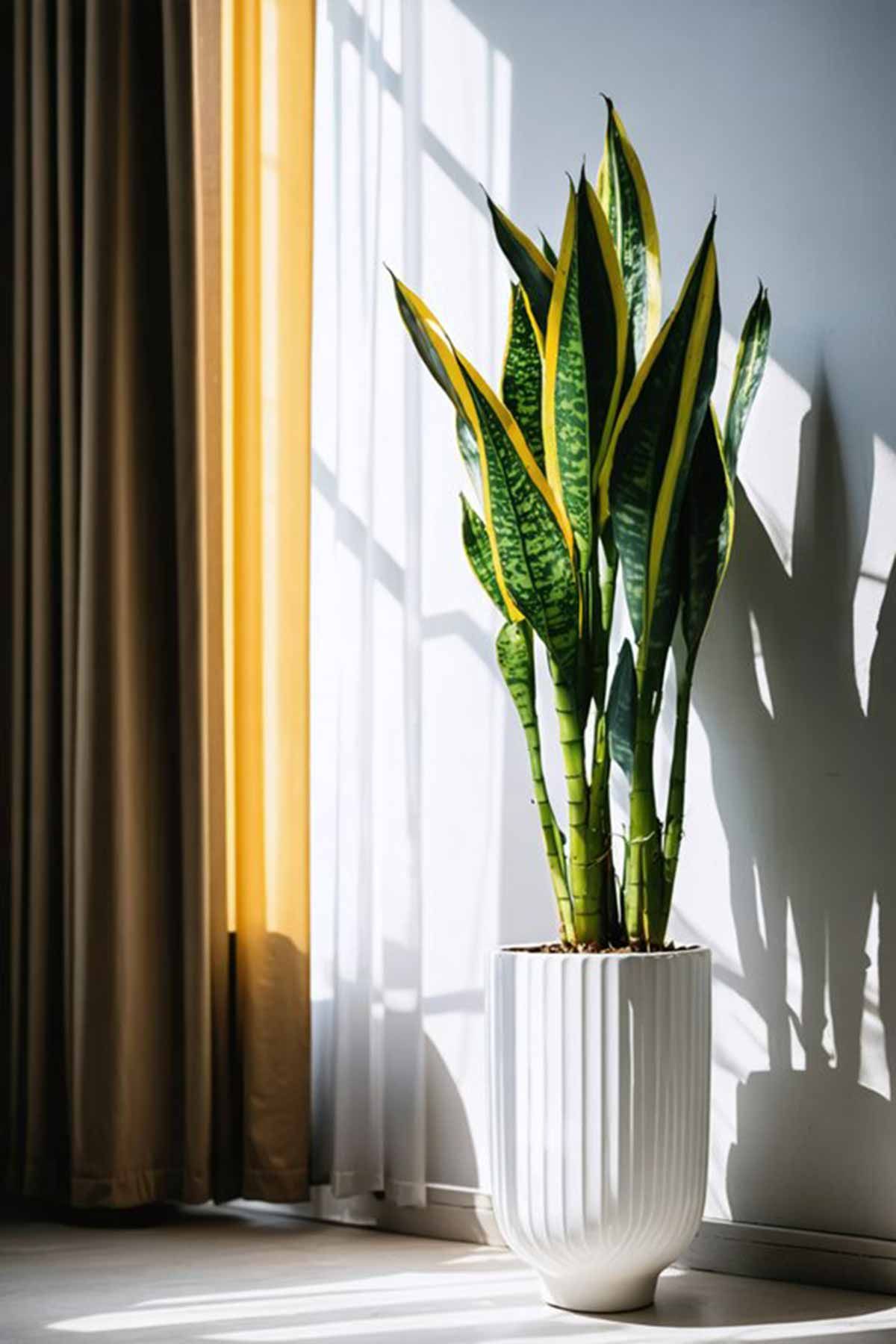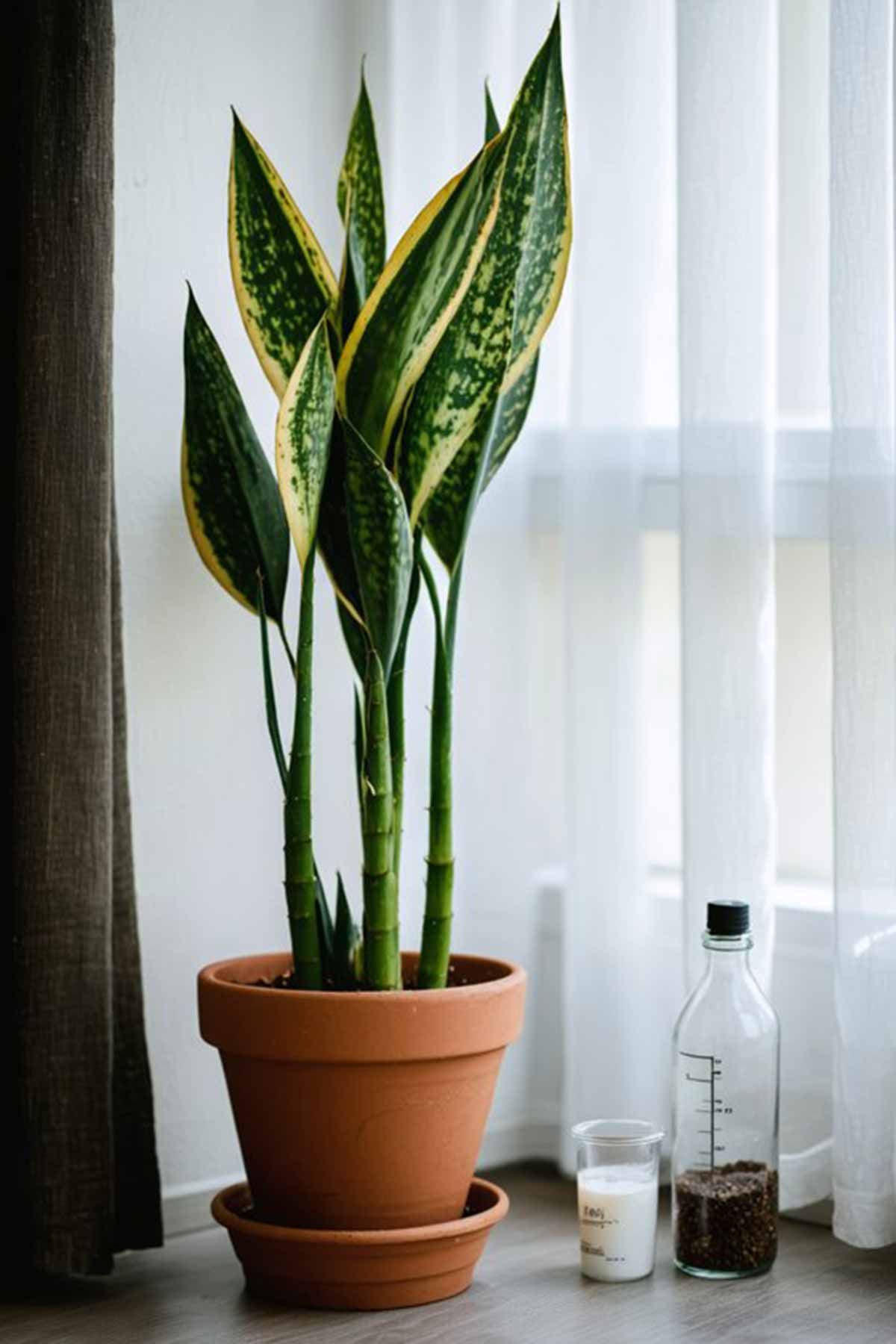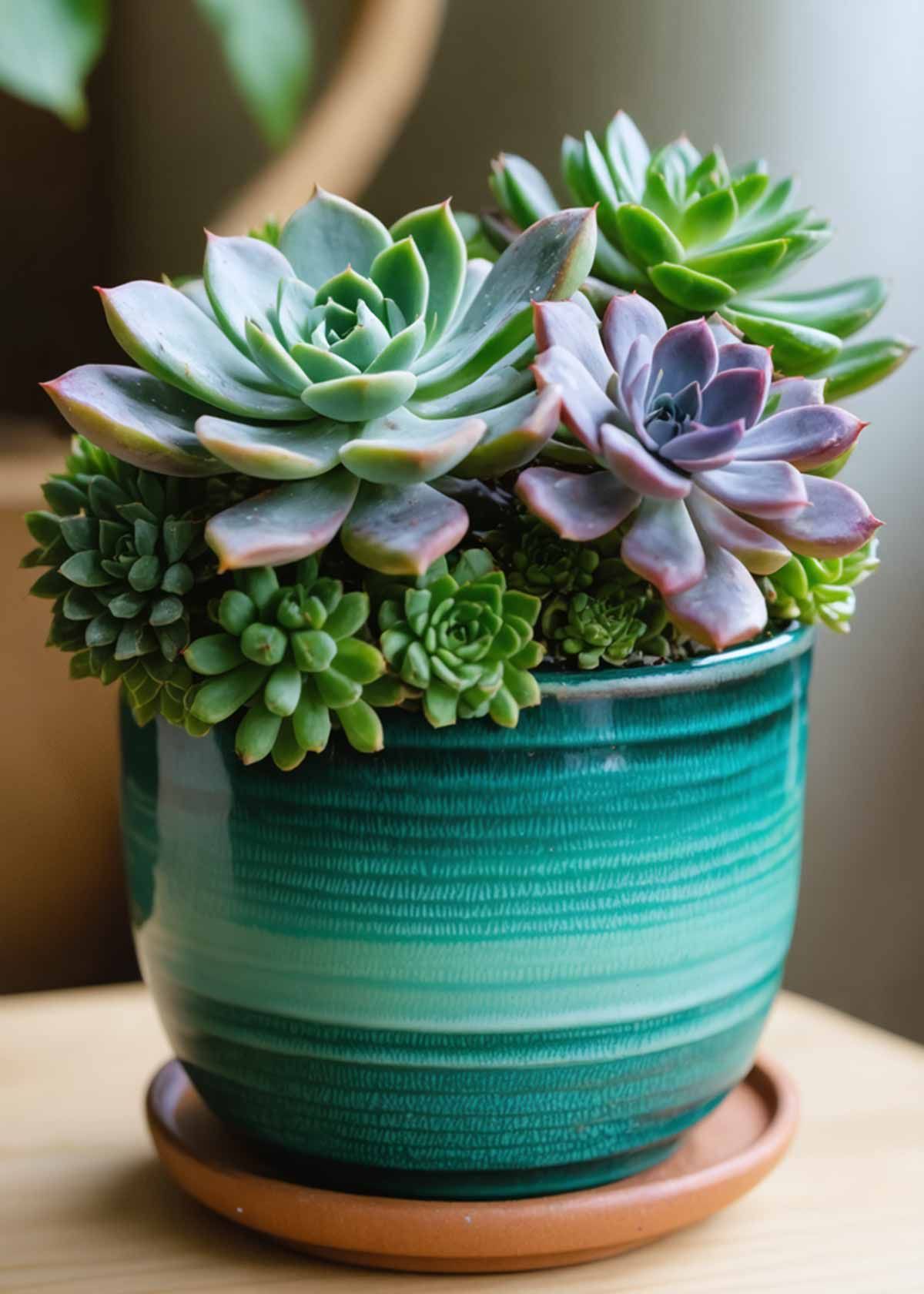How To Take Care Of Your Snake Plant
How To Take Care Of Your Snake Plant
Your snake plant will thrive in bright indirect light but tolerates low light conditions too. Water only when the top 2 inches of soil feel dry, and use well-draining soil to prevent root rot. Keep temperatures between 65-85°F and maintain moderate humidity. Remove yellowed or damaged leaves promptly, and watch for signs of overwatering. With these basic care tips as your foundation, you'll discover how truly adaptable and rewarding these striking plants can be.
Light Requirements: Finding the Perfect Spot
While snake plants can tolerate various light conditions, they thrive best in bright, indirect sunlight.
Place your plant near an east or west-facing window where it'll receive filtered light throughout the day. You can also position it a few feet away from a south-facing window to avoid harsh afternoon rays.
Don't worry if you've got a dimmer spot - snake plants will survive in low-light areas, though they'll grow slower and may lose their vibrant leaf patterns.
Just keep them away from intense direct sun, which can scorch their leaves. If you notice the leaves turning yellow or developing brown spots, that's a sign your plant's getting too much light.
Move it to a more suitable location where it'll receive gentler illumination.
Watering Schedule and Moisture Needs
Before you add water to your snake plant, stick your finger about two inches into the soil to check if it's dry, as these hardy plants prefer to dry out between waterings.
You'll need to adjust your watering frequency based on the seasons, watering less during winter months when growth slows down and more during active growing periods in spring and summer.
If you notice yellowing leaves, soggy soil, or a foul smell, you're likely overwatering your plant and should immediately reduce the frequency of your waterings.

Checking Soil Before Watering
To properly water your snake plant, you'll need to check the soil moisture first. Insert your finger about 2 inches into the soil - if it feels dry at this depth, it's time to water. You can also use a moisture meter for a more accurate reading.
The top layer of soil can be misleading, as it dries faster than deeper layers. Don't rely solely on the surface appearance to determine watering needs. If the soil feels even slightly damp below the surface, wait a few more days before watering.
A wooden chopstick can serve as another testing tool - insert it into the soil and leave it for a minute. If soil particles stick to it when removed, the soil still contains adequate moisture. If it comes out clean, your plant needs water.
Seasonal Watering Changes
Snake plants require different watering frequencies throughout the year as seasons change. During winter months, your plant enters a dormant phase and needs less water, while spring and summer bring active growth periods requiring more frequent watering.
Adjust your watering schedule according to these seasonal patterns:
- Spring - Water every 2-3 weeks as growth resumes and temperatures warm up.
- Summer - Increase to weekly watering during peak growing season, checking soil moisture.
- Fall - Reduce watering to every 3-4 weeks as growth slows down.
- Winter - Water sparingly, typically every 4-6 weeks while plant is dormant.
Monitor your plant's specific needs, as indoor temperature, humidity, and light exposure can affect water requirements regardless of season.
Always let the soil dry between waterings to prevent root rot.
Signs of Overwatering
Although snake plants are drought-tolerant and resilient, they're particularly susceptible to overwatering damage. If you notice your snake plant's leaves turning yellow, soft, or mushy, you're likely giving it too much water. Watch for leaves that droop, fall over, or develop brown spots, as these are clear warning signs of root rot setting in.
| Warning Sign | What It Means |
|---|---|
| Yellow leaves | Root system stress |
| Mushy Base | Active root rot |
| Foul Soil Smell | Bacterial growth |
Check the soil moisture level by inserting your finger about 2 inches deep - if it feels wet, skip watering. Don't water again until the top half of the soil feels completely dry. Remember, it's easier to revive an underwatered snake plant than to save one that's been overwatered.
Soil Type and Drainage Essentials
Your snake plant needs a well-draining soil mix consisting of regular potting soil combined with perlite or coarse sand to prevent water retention.
You'll want to make sure your plant's container has drainage holes at the bottom to allow excess water to escape freely.
These proper soil and drainage conditions will help you avoid deadly root rot, which can quickly kill your snake plant if left unchecked.
Well-Draining Soil Mix
The right soil mix plays a crucial role in keeping snake plants healthy and thriving. To create well-draining soil, combine regular potting soil with coarser materials that promote proper drainage and aeration. This mixture prevents root rot and guarantees your plant's root system stays healthy.
A perfect soil mix for snake plants includes:
- Two parts quality potting soil as the base medium
- One part coarse sand or perlite to improve drainage
- One part pumice or crushed gravel for additional aeration
- Half part coco coir or pine bark to retain minimal moisture
Mix these components thoroughly before potting your snake plant.
You'll know you've achieved the right consistency when water flows freely through the soil without pooling on top or becoming waterlogged at the bottom.
Proper Container Drainage
While selecting an appropriate pot is important, ensuring proper drainage is essential for snake plant survival. You'll need drainage holes at the bottom of your container to prevent water from pooling and causing root rot. Add a layer of gravel or pebbles at the base to improve water flow.
| Plant Health | Drainage Signs | Action Needed |
|---|---|---|
| Healthy Roots | Water Flows freely | Continue as is |
| Yellow leaves | Slow drainage | Add drainage holes |
| Root Rot | Standing water | Repot immediately |
| Soil Mould | Damp Surface | Reduce watering |
| Wilting | Compacted Soil | Aerate Soil / Repot |
Always check that water runs through the pot easily by performing a drainage test before planting. If you're using a decorative pot without holes, place your snake plant in a well-draining nursery pot inside it. Remove excess water from the catch tray within 30 minutes of watering.
Avoid Root Rot
Proper drainage works hand-in-hand with selecting the right soil type to prevent root rot in snake plants.
You'll want to use well-draining potting soil mixed with perlite or coarse sand to create ideal growing conditions. This combination allows excess water to flow through while retaining just enough moisture for healthy growth.
To protect your snake plant from root rot:
- Choose a fast-draining potting mix specifically formulated for succulents
- Add 30% perlite or coarse sand to improve soil aeration
- Check the roots every 6 months for signs of decay or discoloration
- Let the soil dry completely between waterings
If you notice soft, brown, or mushy roots, immediately remove affected areas with clean scissors and repot in fresh soil to save your plant.

Temperature and Humidity Preferences
Snake plants thrive in typical indoor temperatures between 65-85°F (18-29°C), making them ideal houseplants for most homes. They're tolerant of temperature fluctuations but don't do well in cold conditions below 50°F (10°C). You'll want to keep them away from drafty windows and air conditioning vents.
| Temperature Condition | Plant Response |
|---|---|
| Below 50°F (10°C) | Damage to leaves |
| 50-65°F (10-18°C) | Slowed growth |
| 65-85°F (18-29°C) | Best growth |
| Above 85°F (29°C) | Stress possible |
As for humidity, snake plants aren't fussy. They adapt well to average indoor humidity levels between 30-50%. You don't need a humidifier, and you shouldn't mist the leaves as this can lead to fungal problems. These hardy plants actually prefer drier conditions.
Propagation Methods and Techniques
Three reliable methods exist for propagating snake plants: leaf cuttings in water, leaf cuttings in soil, and division of mature plants.
You'll find that water propagation is the simplest method, while division offers the quickest results. For soil propagation, you'll need well-draining potting mix and rooting hormone.
To propagate your snake plant successfully:
- Cut healthy leaves into 4-inch sections, ensuring you maintain the "up" direction they grew in.
- Let cut ends callus for 24 hours before placing in water or soil.
- Keep propagating plants in bright, indirect light at room temperature.
- Wait 4-8 weeks for roots to develop before transplanting water-propagated cuttings.
Remember to keep the soil slightly moist during root development, but don't overwater, as this can cause rotting.
Common Problems and Solutions
While propagation can help you grow new plants, being aware of potential issues will help you maintain their health. Snake plants are generally hardy, but they can face several common problems that you'll need to address quickly.
| Problem | Solution |
|---|---|
| Yellow leaves | Reduce watering frequency; check for root rot |
| Brown leaf tips | Increase humidity; move away from direct sunlight |
| 65-85°F (18-29°C) | Water thoroughly; verify proper drainage |
Watch for leaf discoloration, which often indicates overwatering or poor drainage. If you notice soft, mushy stems, remove affected areas immediately to prevent rot from spreading. Pests like spider mites and mealybugs can attack your snake plant - treat them with neem oil or insecticidal soap. Remember that most snake plant problems stem from overwatering, so always let the soil dry between waterings.
Frequently Asked Questions
Are Snake Plants Toxic to Pets and Children?
You'll need to keep snake plants away from pets and children as they're mildly toxic. If ingested, they can cause nausea, vomiting, and diarrhoea in both humans and animals.
How Long Can Snake Plants Live With Proper Care?
You'll find that snake plants can live for 20-25 years when properly cared for. With excellent conditions and maintenance, they've been known to thrive for several decades in indoor environments.
Can Snake Plants Be Planted With Other Houseplants?
While you can plant snake plants with others, it's best to keep them separate. They have different watering needs and their aggressive root system might compete with neighbouring plants.
Do Snake Plants Bloom, and What Do the Flowers Look Like?
You'll rarely see your snake plant bloom indoors, but when it does, you'll notice tall stalks with small, fragrant white or cream-colored flowers clustering along them like delicate stars.
Should I Clean My Snake Plant's Leaves, and How Often?
You should clean your snake plant's leaves once a month using a damp cloth to remove dust. This helps the plant photosynthesize better and keeps its striking appearance looking fresh.
Conclusion
You'll find that snake plants are one of the most forgiving houseplants you can grow. By following proper light, water, and soil requirements, you're setting yourself up for success. Don't worry too much if you make a few mistakes along the way - these resilient plants can bounce back from most issues. With minimal care and attention, your snake plant will thrive for years to come.

More Plant and Garden Posts

About The Author
I'm Channing and I am the driving force behind Platypus and Pine. I've had over 30 years of experience in designing, renovating and customising Australian homes.
I've used everything from aluminium to velvet as decor choices and love a wide variety of styles and themes.
My absolute favourite is Mid Century Modern and I was fortunate enough to spend 2 weeks in Palm Springs for Modernism week just last year.



